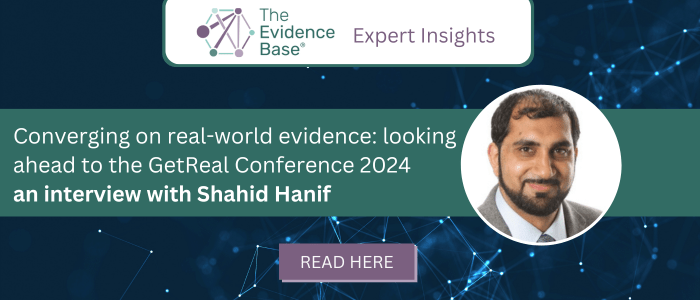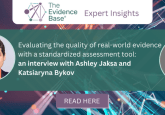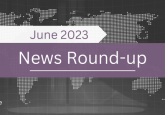Converging on real-world evidence: looking ahead to the GetReal Conference 2024

In March 2023, the inaugural 1st GetReal Institute Annual Conference brought together various stakeholder groups including regulators, health technology assessment (HTA) bodies, academia, industry (both pharma and non-pharma), as well as patient representatives who shared insights on recent developments and the future direction of real-world evidence (RWE) in Europe and in the rest of the world. Building on the success of this meeting, the GetReal Institute’s 2024 Annual Conference (May 14–15, 2024, Utrecht, The Netherlands) will delve deeper by explore the growing and converging role of RWE for regulatory, HTA and clinical decision-making.
Here we catch up with Shahid Hanif to learn what the GetReal Institute has achieved over the past year and what attendees can expect from the GetReal Institute 2024 Annual Conference.
Shahid, many thanks for speaking with The Evidence Base again. I hope you’ll agree there were many developments in RWE over the past year. What stands out for you?
I think the continued development of RWE guidance and frameworks issued and in development by regulatory and HTA bodies as well as professional bodies are a testament to the growing development of real-world data (RWD) and RWE. We’ve seen developments from the FDA with their guidance documents, the EMA’s continued delivery of the work plan from the big data steering group, the ICH reflection paper, and the CIOMS work on RWD and RWE in regulatory decision-making are also notable developments. Likewise, HTA bodies have a greater interest in developing RWE guidance and frameworks for medicines, devices, and digital health technologies. We’ve seen ongoing developments with NICE, CADTH and Health Canada, and in other European countries, which we’ll hear about at the GetReal Institute 2024 Annual Conference, including some recent work from the Institute for Health Sciences of Aragon (IACS), one of the Spanish regional HTA bodies.
In addition to work on the guidance front, we see the continued emergence of use cases/case studies and the proliferation of projects relating to RWD and RWE. For instance, the FDA demonstration projects and the analysis of studies under DARWIN EU are continuing to progress, with an expectation to expand their work further over the next few years. Then of course you have other organizations and initiatives looking to progress their RWE projects, such as the five Horizon Europe-funded projects, part of the MetReal cluster, the Friends of Cancer Research RWE pilot projects, as well as the IHI-funded IDERHA project to access, integrate and analyze health date for patient care and medical research to name a few.
For the GetReal Institute 2024 Annual Conference, what was interesting for us is where we’re seeing this convergence of regulation and HTA, and what this means in the context of RWE. On an international level, when it comes to the global regulatory space, we’re seeing advancement of the work laid down by the International Coalition of Medicines Regulatory Authorities (ICMRA) towards harmonization and convergence of regulatory organizations. From the European context, there is also convergence between regulatory and HTA organizations through the European Regulation on Health Technology Assessment (HTAR)-mandated joint scientific consultations. Within HTA organizations, harmonization is needed through the joint clinical assessments, as well as by member states looking to leverage these assessments.
“That’s why the theme around convergence between regulatory and HTA becomes really important. The GetReal Institute as an organization has focused on facilitating the adoption of RWE. Our lens is to understand the role of RWD and RWE within this space and how it is potentially going to contribute towards this convergence.”
Can you discuss what the GetReal Institute has accomplished over the past year?
Last year we completed two projects commissioned through academic research groups. One of which, the Criteria for Pivotal Evidence with Leiden University Medical Center, looked at some of the measures which are involved in regulatory decision-making using RWE. The findings were published earlier this year, with a follow-up paper expected. This work has formed a bedrock of understanding some of the different criteria involved in using RWD and RWE in regulatory decision-making. Interestingly, the research team also looked at some of these criteria from an HTA perspective, again highlighting the overlap between regulatory and HTA bodies in using RWE in this context.
The second project, with the Division of Pharmacoepidemiology and Clinical Pharmacology at Utrecht University, looked at the increasing use of external control arm studies and specifically to compare the analytical methods from scientific literature with recommendations in guidelines to identify methodological gaps with regulatory and HTA decision-making practice; a publication on this topic with recommendation to improve the quality of these methods is forthcoming. Interestingly this has led to a follow-on project that we are currently undertaking in collaboration with one of our members, IQVIA, in collaboration of our Data and Methods Working Group, aimed at developing a best practice framework for evidence generation in external comparators. We aim to publish this framework at the end of the year.
The third thing to mention is we established our Shared Learning Forum initiative that has been in development for the past 18 months through discussion with various stakeholders. The Shared Learning Forum allows stakeholders to convene and discuss actual examples of RWE study approaches to answering real-life research questions about study data, design, methods, processes, and decision-maker evaluations enabling all parties to learn from the experience of successful and unsuccessful uses of RWE to support regulatory, reimbursement and payment decisions. In December 2023, we held our first Shared Learning Forum workshop bringing together different stakeholders to discuss registry-based RWE case studies for HTA decision-making. A summary and deep dive of the forum are available.
We plan to have the forum as a sustainable platform for a multitude of topics suggested by members and interested parties that we can explore more in deep dive sessions. By iteratively sharing some of these experiences with the different stakeholders we can foster better understanding of the applicability of RWD and RWE, where there are questions around uncertainty and the viewpoints of the different stakeholders. This will hopefully lead towards a better understanding of the application of RWD and RWE, and ultimately inform decision-makers about the acceptability and use of RWE and RWD.
You’ve mentioned convergence between and within regulatory and HTA bodies and this forms the basis of this year’s GetReal Institute 2024 Annual Conference with the theme, ‘A growing convergence: RWE for regulatory and HTA decision-making’. What do we mean by ‘convergence’, and, in your opinion, what is needed to achieve this?
This is a very interesting question and one that we really want to try and explore through the conference: what does ‘convergence’ mean to the different stakeholders? We have seen the terminology around harmonization and convergence being used within the regulatory and HTA space.
“For me, convergence is realizing that there are opportunities for stakeholders to align in areas of common interests. We can see the convergence between regulatory organizations and between HTA bodies, and interestingly more structured interaction between regulatory and HTA bodies. This convergence enables public bodies to align, learn and better utilize the resources available to them.”
One of the key issues, particularly for public stakeholders, is their capacity to manage the emerging innovations. Convergence then becomes an opportunity to explore how can we work potentially better through aligning on the areas where we have both a common interest and a common understanding. Can we arrive at that understanding, so that we can do things in a more efficient way for the healthcare systems?
Recognizing that certain challenges are shared across various member states, such as health system capacity issues, underscores the importance of understanding and comparing different approaches. While specific product usage may differ, understanding these diverse approaches can drive convergence in addressing these challenges.
There’s also a struggle from the industry side in terms of navigating the landscape to ensure that patients can access innovations more readily. Having that understanding within the health systems enables them to think about how they could plan and conduct RWE- and RWD-related studies, and which are going to be more acceptable for a broader set of stakeholders, as opposed to being selective about what types of work they’re conducting. There’s a big drive to ensure there is more equitable access to innovations across Europe so it’s not just those health systems who are able to afford it or have the capacity and the capability to reimburse those medicines. A big part of this is being able to achieve this for patient access.
How has the conference program been tailored to address this theme and who can we expect to hear from?
It became very clear from last year’s conference there was an opportunity to think about how things look from the different regulatory and HTA perspectives and to bring them together to explore their communal interests. As the conference has developed, it also highlights certain nuances where you have convergence within the regulatory and HTA bodies as well as between them. Another aspect to consider is the perspective of various stakeholders, who also face challenges regarding the capacity to conduct such studies. When resources are limited, as is the case for any organization, prioritizing becomes essential. This is where the convergence aspect becomes particularly intriguing as it aims to facilitate prioritization and resource allocation effectively.
Central to the discussion at this conference is discerning the objectives of convergence. What are the stakeholders aiming for? What capabilities do they seek to foster? What does ‘good’ look like?
Within the conference program, the idea is to have a focus on regulatory, HTA and scientific developments and bring all these together to highlight the convergence and opportunities of using RWE to enable this. From the regulatory perspective, we have speakers from both EMA and FDA as well as MHRA and Medicines Evaluation Board who will provide that regulatory context in terms of ‘what does good look like?’
Having published their ‘vision’, the EMA and the Big Data Steering Group have highlighted the direction in which they want to go with RWE, and it will be interesting to hear from them as well as the continued developments of the FDA. On the HTA side, we are trying a novel format this year of a debate relating to RWE adoption in support of the HTA regulation. This presents an excellent opportunity to listen to perspectives from both sides, with some speakers arguing that significant strides have been made in leveraging RWE for HTA and regulatory purposes, while others emphasizing the opposing viewpoint, advocating for necessary actions yet to be taken. The aim is to identify what is going to help move us in the right direction, and having a debate style and audience participation should help towards achieving this. We’ll end the first day with practical experiences of HTA bodies in using RWE methods.
On the second day of the conference, we will have a series of presentations from different initiatives on the practical application of RWE. The keynote speakers from regulatory and HTA will outline their vision for the future relating to the convergence of these and the role of RWE. Finally, the ‘town hall’ will bring together all stakeholders for an open discussion on what concrete actions are needed.
If we spoke again in 10 years, how would you like RWE for health care and regulatory decision-making to have evolved?
Often, it’s helpful first to reflect on the last 10 years and assess what’s really changed. It’s been almost 10 years since GetReal started as an IMI project, when there were not as many initiatives working on RWD and RWE. Over the last few years, we’ve seen an exponential growth of work within this space from the perspective of all stakeholders. If you fast forward to another 10 years, this is only likely to increase.
“The key part of this is going to be how RWE and RWD become acceptable to public bodies, and how we can conduct these types of studies more efficiently, understand both the limitations as well as the opportunities, and apply the use of RWE and RWD better.”
There are some very systemic challenges in terms of the generation and the use of this data and evidence, which is still a key issue. How do you ensure that you have that data accessible and it is of fit-for-purpose quality? Addressing some of these limitations and understanding the use of the data and evidence within contexts and with a growing number of case studies is key. There are ongoing challenges on how to improve collating that initial evidence and data for research purposes, where I would expect there to be significant developments. There are people who have been in this space for a long time that still view these as persistent challenges. Sceptics may argue these fundamental challenges will persist despite efforts to address them.
“My optimistic self believes we will have strides towards working more collaboratively in addressing these challenges. I think that it’s going to make a huge difference over the next 10 years; how we’re able to work more collaboratively to improve the generation, use and acceptability of RWD and RWE, and have a better understanding of its use as well as its limitations.”
Disclaimer:
The opinions expressed in this feature are those of the interviewee/author and do not necessarily reflect the views of The Evidence Base® or Becaris Publishing Ltd.






